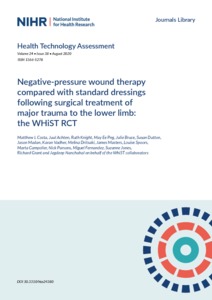Costa, ML;
Achten, J;
Knight, R;
Png, ME;
Bruce, J;
Dutton, S;
Madan, J;
Vadher, K;
Dritsaki, M;
Masters, J;
et al.
Costa, ML; Achten, J; Knight, R; Png, ME; Bruce, J; Dutton, S; Madan, J; Vadher, K; Dritsaki, M; Masters, J; Spoors, L; Campolier, M; Parsons, N; Fernandez, M; Jones, S; Grant, R; Nanchahal, J
(2020)
Negative-pressure wound therapy compared with standard dressings following surgical treatment of major trauma to the lower limb: the WHiST RCT.
Health Technol Assess, 24 (38).
pp. 1-86.
ISSN 2046-4924
https://doi.org/10.3310/hta24380
SGUL Authors: Hing, Caroline Blanca
![[img]](https://openaccess.sgul.ac.uk/113105/1.hassmallThumbnailVersion/3033585.pdf)  Preview |
|
PDF
Published Version
Available under License ["licenses_description_publisher" not defined].
Download (1MB)
| Preview
|
Abstract
BACKGROUND: Major trauma is the leading cause of death in people aged < 45 years. Patients with major trauma usually have lower-limb fractures. Surgery to fix the fractures is complicated and the risk of infection may be as high as 27%. The type of dressing applied after surgery could potentially reduce the risk of infection. OBJECTIVES: To assess the deep surgical site infection rate, disability, quality of life, patient assessment of the surgical scar and resource use in patients with surgical incisions associated with fractures following major trauma to the lower limbs treated with incisional negative-pressure wound therapy versus standard dressings. DESIGN: A pragmatic, multicentre, randomised controlled trial. SETTING: Twenty-four specialist trauma hospitals representing the UK Major Trauma Network. PARTICIPANTS: A total of 1548 adult patients were randomised from September 2016 to April 2018. Exclusion criteria included presentation > 72 hours after injury and inability to complete questionnaires. INTERVENTIONS: Incisional negative-pressure wound therapy (n = 785), in which a non-adherent absorbent dressing covered with a semipermeable membrane is connected to a pump to create a partial vacuum over the wound, versus standard dressings not involving negative pressure (n = 763). Trial participants and the treating surgeon could not be blinded to treatment allocation. MAIN OUTCOME MEASURES: Deep surgical site infection at 30 days was the primary outcome measure. Secondary outcomes were deep infection at 90 days, the results of the Disability Rating Index, health-related quality of life, the results of the Patient and Observer Scar Assessment Scale and resource use collected at 3 and 6 months post surgery. RESULTS: A total of 98% of participants provided primary outcome data. There was no evidence of a difference in the rate of deep surgical site infection at 30 days. The infection rate was 6.7% (50/749) in the standard dressing group and 5.8% (45/770) in the incisional negative-pressure wound therapy group (intention-to-treat odds ratio 0.87; 95% confidence interval 0.57 to 1.33; p = 0.52). There was no difference in the deep surgical site infection rate at 90 days: 13.2% in the standard dressing group and 11.4% in the incisional negative-pressure wound therapy group (odds ratio 0.84, 95% confidence interval 0.59 to 1.19; p = 0.32). There was no difference between the two groups in disability, quality of life or scar appearance at 3 or 6 months. Incisional negative-pressure wound therapy did not reduce the cost of treatment and was associated with a low probability of cost-effectiveness. LIMITATIONS: Owing to the emergency nature of the surgery, we anticipated that some patients who were randomised would subsequently be unable or unwilling to participate. However, the majority of the patients (85%) agreed to participate. Therefore, participants were representative of the population with lower-limb fractures associated with major trauma. CONCLUSIONS: The findings of this study do not support the use of negative-pressure wound therapy in patients having surgery for major trauma to the lower limbs. FUTURE WORK: Our work suggests that the use of incisional negative-pressure wound therapy dressings in other at-risk surgical wounds requires further investigation. Future research may also investigate different approaches to reduce postoperative infections, for example the use of topical antibiotic preparations in surgical wounds and the role of orthopaedic implants with antimicrobial coatings when fixing the associated fracture. TRIAL REGISTRATION: Current Controlled Trials ISRCTN12702354 and UK Clinical Research Network Portfolio ID20416. FUNDING: This project was funded by the National Institute for Health Research Health Technology Assessment programme and will be published in full in Health Technology Assessment; Vol. 24, No. 38. See the NIHR Journals Library for further project information.
| Item Type: |
Article
|
| Additional Information: |
© Queen’s Printer and Controller of HMSO 2020. This work was produced by Costaet al.under the terms of a commissioning contract issued by the Secretary of State for Health and Social Care. This issue may be freely reproduced for the purposes of private research and study and extracts (or indeed, the full report) may be included in professional journals provided that suitable acknowledgement is made and the reproduction is not associated with any form of advertising. Applications for commercial reproduction should be addressed to: NIHR Journals Library, National Institute for Health Research, Evaluation, Trials and Studies Coordinating Centre, Alpha House, University of Southampton Science Park, Southampton SO16 7NS, UK |
| Keywords: |
FRACTURE SURGERY, NEGATIVE PRESSURE WOUND THERAPY, SURGICAL SITE INFECTION, WOUND DRESSINGS, 1117 Public Health and Health Services, 0807 Library and Information Studies, 0806 Information Systems, Health Policy & Services |
| SGUL Research Institute / Research Centre: |
Academic Structure > Molecular and Clinical Sciences Research Institute (MCS) |
| Journal or Publication Title: |
Health Technol Assess |
| ISSN: |
2046-4924 |
| Language: |
eng |
| Dates: |
| Date | Event |
|---|
| August 2020 | Published | | June 2019 | Accepted |
|
| Publisher License: |
Publisher's own licence |
| Projects: |
|
| PubMed ID: |
32821038 |
| Web of Science ID: |
WOS:000562997400001 |
 |
Go to PubMed abstract |
| URI: |
https://openaccess.sgul.ac.uk/id/eprint/113105 |
| Publisher's version: |
https://doi.org/10.3310/hta24380 |
Statistics
Item downloaded times since 30 Mar 2021.
Actions (login required)
 |
Edit Item |



